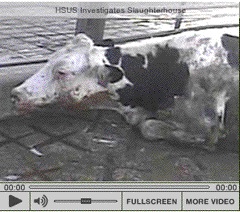In Feb. 2008, the U.S. Department of Agriculture shut down a meat processing company after concluding workers committed egregious acts of animal cruelty, about a week after the Humane Society of the United States released video showing employees of the Hallmark/Westland  Meat Packing Co. of Chino, Calif., tormenting cows that were too injured or weak to stand.
Meat Packing Co. of Chino, Calif., tormenting cows that were too injured or weak to stand.
That $100-million-a-year company does not exist anymore – brought down by someone using an over-the-counter video recording device.
An employee of the Humane Society of the United States worked undercover inside the company for about six weeks in the fall, secretly recording what went on.
His video shows what appear to be crippled cows dragged with forklifts, sprayed in the face with a high-pressure water hose and poked in the eye with a stick.
The images sparked concern not only from animal-welfare advocates, but from food-safety experts, who feared the company might have used the tactic to prod sick animals to slaughter in violation of state and federal regulations.
At the time I said maybe it was time for USDA to adopt some new inspection and investigative techniques if the HSUS can so easily document such grotesquely poor treatment of animals.
In April, 2008, Dr. Richard Raymond of USDA said the department needed neither video cameras nor more inspectors to police slaughterhouses after the country’s largest beef recall earlier this year.
Everything was just fine.
In March 2009, Cargill Beef decided to do their own thing – probably because when an outbreak or outrage happens, the USDA or any other regulatory types, don’t lose their jobs, it’s the producers, processors and employees who lose money and their jobs — and implemented a third-party video-auditing system that would operate 24 hours a day at its U.S. beef slaughter plants to enhance the company’s animal welfare protection systems.
A year later, Cargill announced it was expanding its remote video auditing program to monitor food-safety procedures within processing plants.
Mike Siemens, Cargill leader of animal welfare and husbandry, said at the time,
“The early results with our animal welfare program have been terrific … In addition to the positive results on compliance rates, we have observed healthy competition among plants on performance scores, as well as a general theme of collaboration among plants on how to attack specific operational challenges. The ability to share data and video easily is extremely valuable.”
If the U.S. regulators aren’t listening, the Brits are.
The U.K. Food Standards Agency tabled a proposal last week to introduce CCTV (closed circuit television) cameras into slaughterhouses in a bid to tackle animal welfare abuse.
Food Production Daily cited FSA director of operations Andrew Rhodes as saying the agency is calling for the voluntary introduction of surveillance cameras after undercover filming by animal rights group  Animal Aid in the last year had highlighted abuses in U.K. slaughterhouses. The proposal is due to go before agency chiefs next week for approval.
Animal Aid in the last year had highlighted abuses in U.K. slaughterhouses. The proposal is due to go before agency chiefs next week for approval.
The report said that while there is no legal requirement to fit CCTV, food business operators (FBOs) may come under pressure from retailers to install systems. The FSA acknowledged there were practical issues – such as how the footage in monitored, who has access to it and how long film is kept – that must be addressed.
Agreed. There are lots of issues involved. So figure them out. What slaughterhouse or processor wants to be held hostage by each new hire that may be carrying a video device.
Today, Food Production Daily cited Stephen Rossides, head of the British Meat Processors Association (BMPA), as saying that proposals to fit surveillance cameras in UK slaughterhouses to combat animal welfare abuses must remain voluntary as violations are relatively rare.
I don’t know about the U.K., but at the time of the Westland mess, Julie Schmit of USA Today reported that newly released government records show such animal mishandling in past years was more than a rare occurrence.
The Animal Welfare Institute, an animal-protection group, said that more than 10% of the humane-slaughter violations issued by the U.S. Department of Agriculture for the 18 months ended March 2004 detailed improper treatment of animals that couldn’t walk — mostly cattle.
USDA records obtained by the Animal Welfare Institute describe 501 humane-handling or slaughter violations that occurred at other slaughter plants. At one plant, a downed cow was pushed 15 feet with a forklift. Other companies were cited for dragging downed but conscious animals, letting downed cattle be trampled and stood on by others and, in one case, using "excessive force" with a rope and an electric prod to get a downed cow to stand, the enforcement records say.
Beyond reaction and regulation, producers and processors who say their food is safe should be able to prove it. Producers and processors who say they treat animals humanely should be able to prove it.
